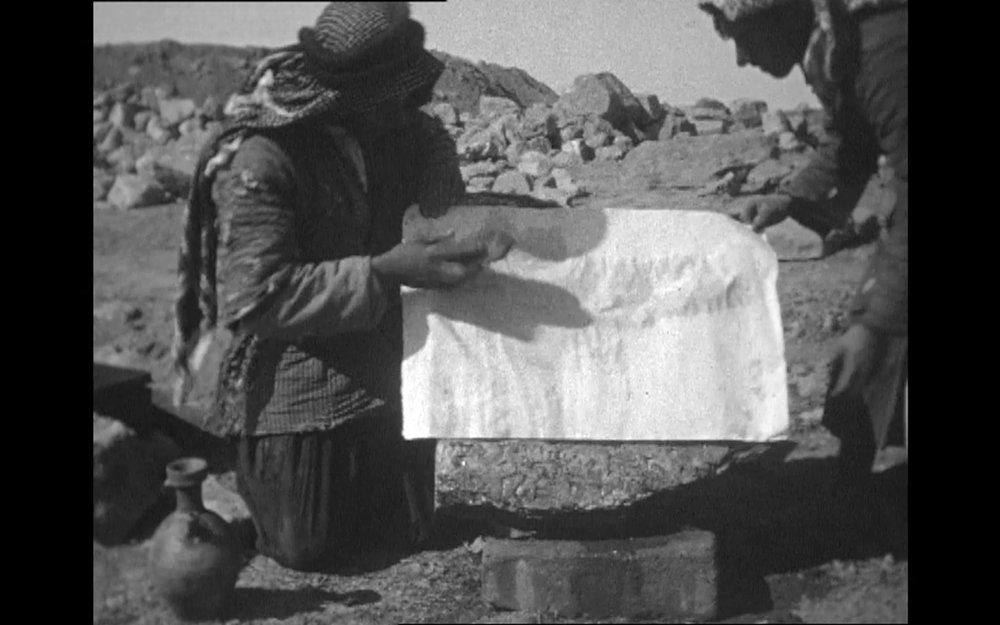Royal Asiatic Society Film Footage of Excavations in Iraq
The RAS Collections hold only two reels of film. These have been digitised and are available to view.
We are grateful to Amara Thornton and Michael McCluskey from the UCL, Filming Antiquity project for their insights into this film.
The footage dates from the late 1920s/early 1930s and shows excavations in Iraq at the mound of Kouyunjik, scenes in the village of Nebi Yunus, across the Khosr river from Kouyunjik within the ancient city boundaries of Nineveh, and scenes in the city of Mosul, across the river Tigris from Nineveh. The footage (at present) has been attributed to Nineveh excavator Reginald Campbell Thompson (1876-1941), a British Assyriologist, epigrapher and archaeologist.
Campbell Thompson directed four seasons at Nineveh – the initial 1927/28 season was followed by three in succession – 1929/30, 1930/31 and 1931/32. He focused on the mound of Kouyunjik, the location of Ashurnasirpal’s palace, and also sought evidence of a temple of the Assyrian goddess Ishtar, which was eventually discovered during the 1930/31 season. Campbell Thompson’s wife, Barbara, joined him on site for all four seasons, credited in the official publications with her work on the “domestic” arrangements. A varied cast of team members included two friends of Barbara’s – Miss Isabel Shaw (1929/30) and Miss M. Hallett (1930/31) – as well as Richard Hutchinson (1929/30) and Robert W. Hamilton (1930/31) and Max Mallowan and Agatha Christie (1931/32). Of the Iraqi members of the excavation, Campbell Thompson specifically credited his overseers Yakub and Abd-el-Ahad, as well as Mejid Shaiya, whom Campbell Thompson referred to as “my old henchman”.
The film has impromptu title cards (no more formal than paper pinned up for the camera) which lead viewers through a sequence of scenes. Reginald Campbell Thompson was intensely interested in the customs, culture and biographies of the people who worked with him and for him on site. Campbell Thompson’s footage, if indeed he was behind the camera, offers scenes similar to other excavation films from this period and other, striking images unique to his own sense of the city of Mosul and its dynamism. Through the camera lens we see the work of the dig in the context of the local culture and geography. We see craft work, leisure activities, and what one intertitle describes as a fête complete with makeshift Ferris wheel.
Other shots are more pedagogical and seemingly geared toward students: a scene shows the ‘squeeze’ process of transferring stone inscriptions onto paper and washing delicate pottery fragments. One interesting sequence shows off the different modes of transportation that intersect each day; crossing the screen we see a donkey drawing a carriage, a bicycle, and a motor car. This interest in different modes of transportation extends to the delicate process of ‘sending home’ items unearthed on the dig as we see workers ‘packing antiquities’ to be sent presumably to Britain.
It is unknown when the reels of film came into the RAS Collections, though it was noted in the Minutes for 13 November 1941 to thanks Mrs Campbell-Thompson for Assyrological slides. It is possible that the films were donated at the same time or were left after a Lecture. Campbell Thompson gave “Excavations at Nineveh 1929-1930” (jointly with R. W. Hutchinson) at the Royal Asiatic Society at 4.30 pm on 25 September 1930; and another lecture on 1 October 1931 (for the 1930-31 season).

























































